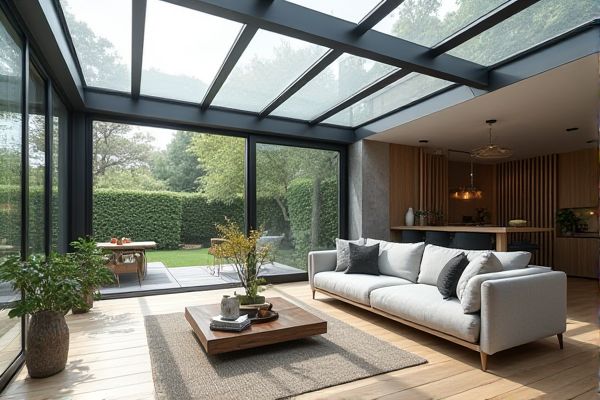
A solid roof offers superior insulation, durability, and privacy for your terrace, while polycarbonate roofs provide lightweight, UV-resistant protection with natural light transmission, making them ideal for bright, open spaces. Explore the rest of the article to determine which terrace roofing option best suits your needs and enhances your outdoor living area.
Table of Comparison
| Feature | Solid Roof | Polycarbonate Roof |
|---|---|---|
| Material | Metal, wood, concrete, or tiles | Durable polycarbonate sheets |
| Durability | Highly durable, long-lasting | Good durability, impact-resistant |
| Light Transmission | Blocks all natural light | Allows natural light to pass through |
| Weather Protection | Excellent protection against rain, snow, UV | Waterproof, UV resistant but less insulated |
| Insulation | Strong thermal insulation | Moderate insulation, may trap heat |
| Installation | Complex, requires professional skills | Relatively easier and faster |
| Cost | Higher initial cost | Lower to moderate cost |
| Aesthetic Appeal | Solid, classic look | Modern, transparent appearance |
| Maintenance | Low maintenance | Requires regular cleaning |
| Best Use | Full shade, durability priority | Light-filled spaces, partial shade |
Introduction: Choosing the Right Terrace Roof
Solid roofs offer superior insulation and durability, making them ideal for year-round protection against extreme weather conditions on terraces. Polycarbonate roofs provide lightweight, UV-resistant coverage that allows natural light to penetrate while safeguarding against harmful radiation. Selecting between solid and polycarbonate terrace roofs depends on factors like climate, desired lighting, and maintenance preferences.
Overview of Solid Roofs
Solid roofs for terraces are constructed from durable materials such as metal, tiles, or wood, offering superior weather resistance and insulation compared to polycarbonate roofs. These roofs provide enhanced privacy and noise reduction, making them ideal for year-round use in various climates. Your choice of a solid roof ensures long-lasting protection and improved energy efficiency for outdoor spaces.
Overview of Polycarbonate Roofs
Polycarbonate roofs offer excellent durability, UV resistance, and lightweight installation compared to solid roofs, making them a popular choice for terrace covers. Their high transparency allows natural light to pass through while providing protection from rain and harmful UV rays, enhancing your outdoor space's comfort. Polycarbonate sheets also offer thermal insulation and flexibility in design, ensuring both functionality and aesthetic appeal for terraces.
Durability Comparison: Solid vs Polycarbonate
Solid roofs typically offer superior durability compared to polycarbonate roofs due to their resistance to harsh weather conditions, impact, and wear over time. Polycarbonate roofs provide lightweight protection and UV resistance but may yellow, warp, or crack under prolonged exposure to extreme weather. Your choice depends on the balance between long-term robustness and the flexibility or affordability polycarbonate materials offer.
Insulation and Temperature Control
A solid roof offers superior insulation and temperature control due to its dense materials, effectively reducing heat transfer and maintaining a consistent indoor climate. Polycarbonate roofs, while allowing natural light, provide less thermal insulation and can result in higher heat buildup under direct sunlight. For terraces requiring energy efficiency and comfort, solid roofs better regulate temperature fluctuations compared to polycarbonate alternatives.
Light Transmission and Ambience
Solid roofs offer minimal light transmission, creating a shaded and cooler terrace environment ideal for complete sun protection. Polycarbonate roofs provide high light transmission rates of up to 90%, enabling a bright and naturally lit ambience while shielding from UV rays. Choosing polycarbonate enhances outdoor enjoyment by maintaining daylight and an open feel, whereas solid roofs prioritize privacy and temperature control.
Installation Process and Complexity
Solid roof installation involves precise cutting, secure framing, and waterproof sealing, often requiring professional skills due to the weight and rigidity of materials like tiles or metal sheets. Polycarbonate roof installation is quicker and more flexible, using lightweight panels that are easier to cut and fit into aluminum framing systems, suitable for DIY projects. Your choice impacts installation time and complexity, with solid roofs demanding more labor and specialized tools compared to the straightforward setup of polycarbonate roofing.
Maintenance Requirements
Solid roofs typically require less frequent maintenance due to their durable materials like metal, tiles, or asphalt shingles that resist weathering and debris buildup. Polycarbonate roofs demand regular cleaning to prevent dirt, algae, and UV damage, with occasional sealing or replacement of panels to maintain transparency and structural integrity. Choosing the right terrace roof depends largely on balancing maintenance efforts with desired aesthetics and durability.
Cost Analysis: Upfront and Long-Term
Solid roofs typically incur higher upfront costs due to materials like metal or shingles but offer superior durability and insulation, reducing long-term energy expenses. Polycarbonate roofs are more affordable initially, providing lightweight and UV-resistant coverage, yet may require frequent replacement or repairs, increasing maintenance costs over time. Evaluating Your budget against expected lifespan and energy efficiency will guide the optimal choice for terrace roofing investments.
Conclusion: Which Roof is Best for Your Terrace?
A solid roof offers superior insulation, durability, and privacy, making it ideal for terraces where weather protection and noise reduction are priorities. Polycarbonate roofs provide excellent light transmission, UV protection, and flexibility, best suited for terraces that benefit from natural daylight and a lighter structure. Choosing the best roof depends on your terrace's specific use, climate conditions, and desired balance between shelter and natural light.
 homyna.com
homyna.com